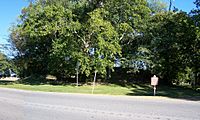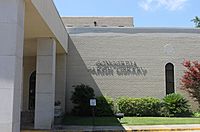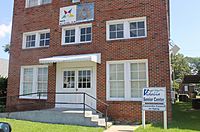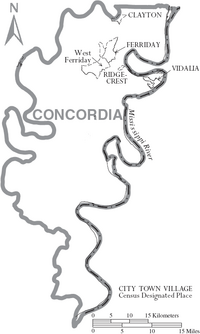Concordia Parish, Louisiana facts for kids
Quick facts for kids
Concordia Parish, Louisiana
|
|
|---|---|
| Parish of Concordia | |
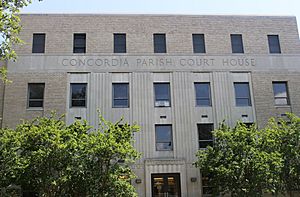
Old Concordia Parish Courthouse in Vidalia
|
|
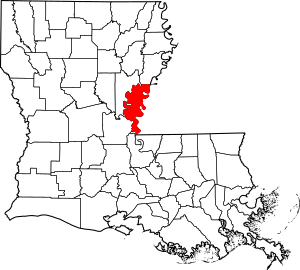
Location within the U.S. state of Louisiana
|
|
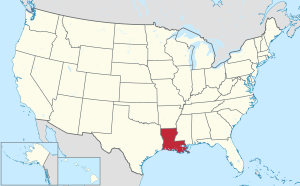
Louisiana's location within the U.S.
|
|
| Country | |
| State | |
| Region | Central |
| Founded | 1807 |
| Named for | Possibly a land grant, New Concordia |
| Parish seat (and largest city) | Vidalia |
| Area | |
| • Total | 1,930 km2 (747 sq mi) |
| • Land | 1,810 km2 (697 sq mi) |
| • Water | 100 km2 (50 sq mi) |
| • percentage | 17 km2 (6.7 sq mi) |
| Population
(2020)
|
|
| • Total | 18,687 |
| • Density | 9.659/km2 (25.016/sq mi) |
| Time zone | UTC-6 (CST) |
| • Summer (DST) | UTC-5 (CDT) |
| Area code | 318 |
| Congressional district | 5th |
Concordia Parish (Spanish: Parroquia de la Concordia; French: Paroisse de Concordia) is a special type of county called a parish in eastern central Louisiana. It is located right along the famous Mississippi River.
In 2020, about 18,687 people lived here. The main town and government center is Vidalia. Concordia Parish was officially created in 1807. It is part of the Natchez, MS–LA Micropolitan Statistical Area, which means it's a smaller city area connected to Natchez.
Historically, this area was known for growing a lot of cotton on large farms called plantations. This was different from southern Louisiana, where sugar cane was the main crop. Other nearby parishes like East and West Carroll, Madison, and Tensas also grew cotton.
Contents
History of Concordia Parish
Concordia Parish has a long and interesting history, going back thousands of years.
Ancient Native American Cultures
For many thousands of years, different groups of Native American people lived in Concordia Parish. They built villages and large earth mounds. Some of these ancient cultures include the Marksville culture, Troyville culture, Coles Creek culture, and Plaquemine culture. You can still see some of their amazing mound sites today, like Cypress Grove Mound, DePrato Mounds, Frogmore Mound Site, and Lamarque Landing Mound.
When the first French explorers and settlers arrived, they met historic Native American tribes living in the area.
How Concordia Got Its Name
The name "Concordia" comes from a Latin word meaning "harmony." Anglo-American settlers, who came after the United States bought this land from France in 1803 (called the Louisiana Purchase), chose this name.
In 1789, a man named Don Jose Vidal, who lived in Natchez, Mississippi, asked for land grants. He wanted to move his family across the Mississippi River to the Louisiana side. In Natchez, there was a large house called Concord (Natchez, Mississippi), where Spanish governors used to live. Vidal moved his family to the Louisiana side after the U.S. took control of the area.
The name "Concord" from that mansion likely inspired the name "Concordia Parish." In 1804, a special ceremony was held. People from Natchez crossed the Mississippi River to celebrate the new land. The original Concord Mansion later burned down in 1901. The Natchez people, a Native American tribe, also lived on both sides of the river.
Early Development and Cotton Farming
Concordia County was officially created on December 2, 1804. It was much larger back then, including parts of what are now East Carroll, Madison, and Tensas parishes. The land between the Mississippi, Red, Black, and Tensaw rivers made up this early area.
The soil in Concordia Parish was very fertile, perfect for growing cotton. This led to the creation of many large cotton plantations. To make these plantations profitable, a very large number of enslaved African Americans were forced to work there. By 1860, about 91% of the people in Concordia Parish were enslaved. This was the highest percentage in any Louisiana parish. Only two counties in Mississippi had a higher percentage of enslaved people.
Geography of Concordia Parish
Concordia Parish covers about 747 square miles. Most of this (697 square miles) is land, and about 50 square miles (6.7%) is water.
The entire parish is made up of rich, flat bottomlands, which are great for farming. The Ouachita River forms the western border, the Red River is to the south, and the mighty Mississippi River is to the east. Large levee systems are built along these rivers to protect the land from floods.
Main Roads
Neighboring Areas
Concordia Parish shares borders with several other parishes and counties:
- Tensas Parish (north)
- Adams County, Mississippi (northeast)
- Wilkinson County, Mississippi (east)
- West Feliciana Parish (southeast)
- Pointe Coupee Parish (south)
- Avoyelles Parish (southwest)
- Catahoula Parish (west)
Protected Natural Areas
- Bayou Cocodrie National Wildlife Refuge
- Richard K. Yancey Wildlife Management Area
Population Facts
| Historical population | |||
|---|---|---|---|
| Census | Pop. | %± | |
| 1820 | 2,626 | — | |
| 1830 | 4,662 | 77.5% | |
| 1840 | 9,414 | 101.9% | |
| 1850 | 7,758 | −17.6% | |
| 1860 | 13,805 | 77.9% | |
| 1870 | 9,977 | −27.7% | |
| 1880 | 14,914 | 49.5% | |
| 1890 | 14,871 | −0.3% | |
| 1900 | 13,559 | −8.8% | |
| 1910 | 14,278 | 5.3% | |
| 1920 | 12,466 | −12.7% | |
| 1930 | 12,778 | 2.5% | |
| 1940 | 14,562 | 14.0% | |
| 1950 | 14,398 | −1.1% | |
| 1960 | 20,467 | 42.2% | |
| 1970 | 22,578 | 10.3% | |
| 1980 | 22,981 | 1.8% | |
| 1990 | 20,828 | −9.4% | |
| 2000 | 20,247 | −2.8% | |
| 2010 | 20,822 | 2.8% | |
| 2020 | 18,687 | −10.3% | |
| U.S. Decennial Census 1790-1960 1900-1990 1990-2000 2010 |
|||
The population of Concordia Parish has changed over the years. In 2020, there were 18,687 people living there. These people lived in 7,162 households, and 4,562 of those were families.
The population is made up of different groups:
- White (non-Hispanic): 54.35%
- Black or African American (non-Hispanic): 40.01%
- Native American: 0.21%
- Asian: 0.62%
- Other/Mixed races: 2.35%
- Hispanic or Latino: 2.46%
Education and Libraries
The Concordia Parish School Board manages the public schools in the parish.
Concordia Parish Library System
The Concordia Parish Library system has three branches and a special bookmobile service. This service brings books and other materials to people all over the parish.
- Ferriday Branch - 1609 Third Street, Ferriday, LA
- Vidalia Branch - 408 Texas Street, Vidalia, LA
- Clayton Branch - 31451 HWY-15 Clayton, LA
Library History
The Concordia Parish Library is very old, being the second oldest parish library in Louisiana. It was also the first one to be supported by taxes. The idea for the library started with a community leader and the State Librarian, Essae Martha Culver, in 1928. Local clubs, the Police Jury (the parish's governing body), and the public worked together. The Concordia Parish Demonstration Library opened in October 1928. People in the parish saw how helpful the library was and voted to have a tax to keep it running. In 1952, the main library moved to its current building in Ferriday, Louisiana.
Getting a Library Card
If you live in Concordia Parish, you can get a library card for free!
- Library Card: This card lets you borrow books and other physical items. You can also use online services. You need two forms of ID that show you live in the parish, plus a photo ID.
- Online Registration: This card gives you access to Wi-Fi, public computers, and online resources like e-books and databases.
Military Presence
The 1086th Transportation Company is part of the National Guard. It is based in Vidalia, Louisiana, on the west side of the Mississippi River.
Communities in Concordia Parish
Concordia Parish has several towns and communities.
Cities and Towns
- Vidalia (This is the main town and the largest one.)
- Ferriday
- Clayton
- Ridgecrest
Smaller Communities
These are areas where people live, but they are not officially organized as cities or towns:
- Minorca
- Monterey
- Spokane
- Acme
- Ashland
- Black Hawk
- Dunbarton
- Eva
- Fairview
- Frogmore
- Mayna
- New Era
- West Ferriday
Famous People from Concordia Parish
Many notable people have come from Concordia Parish:
Arts and Entertainment
- Jerry Lee Lewis, a famous musician
- Jimmy Swaggart, a well-known televangelist
- Mickey Gilley, another popular musician
Journalism
- Campbell Brown, an Emmy-award-winning journalist and former CNN anchor.
- Howard K. Smith, a respected commentator for ABC and CBS news.
See also
 In Spanish: Parroquia de Concordia para niños
In Spanish: Parroquia de Concordia para niños


